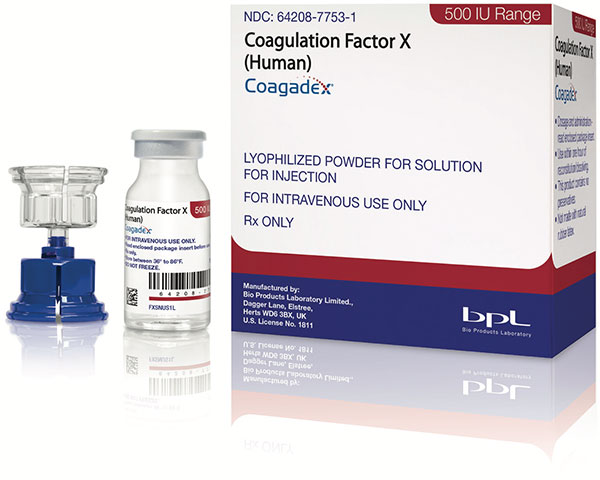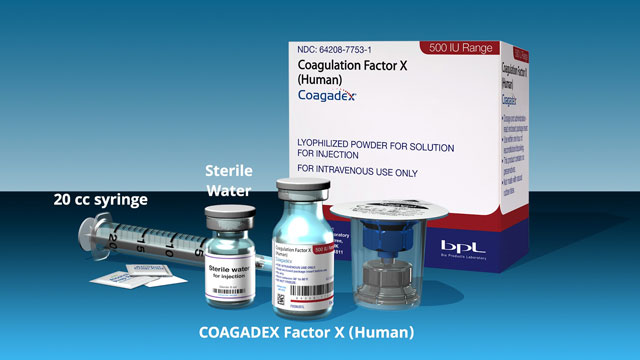What Is COAGADEX?
- COAGADEX is the first and only treatment specifically for hereditary factor X deficiency.
- COAGADEX contains factor X to replace the factor X that is missing in people with hereditary factor X deficiency.
- The factor X in COAGADEX helps the body form clots to stop or prevent excessive bleeding.
- COAGADEX can be taken in different ways—routinely to help prevent bleeding, with surgery to help prevent bleeding, or as needed if bleeding starts.

Why Choose COAGADEX?
COAGADEX is proven effective, but doctors and patients may choose COAGADEX for other reasons also:
High Purity
COAGADEX is high-purity (94%), so you get the factor X you need—without a lot of extra clotting factors. Read More
COAGADEX is the only therapy approved for the treatment of factor X deficiency.
- Other unapproved therapies include clotting factors other than factor X. Too many of the other clotting factors can increase the risk for blood clots that may block blood vessels and cause serious side effects. Examples are stroke or a blood clot in the leg.
Rated Excellent
100% of doctors in a clinical study rated COAGADEX as “excellent” in preventing or reducing the number of bleeds in younger children with hereditary factor X deficiency. Read More
In a medical study that included only children up to 11 years of age with hereditary factor X deficiency, COAGADEX was tested to see how well it could reduce or prevent bleeds.
- 100% of doctors who had patients in the study rated COAGADEX as “excellent” in preventing bleeds or reducing the number of bleeds for all children in the study.
Recommended by Experts
COAGADEX is the #1 recommended treatment by medical experts including a national organization for bleeding disorders.1–3 Read More
COAGADEX is the only treatment for hereditary factor X deficiency that is recommended by the National Hemophilia Foundation’s Medical and Scientific Advisory Council.
- COAGADEX is also recommended by medical experts in rare bleeding disorders. They like it because it has exactly what is needed—factor X—without a lot of extra clotting factors.
How Does COAGADEX Work?
COAGADEX contains factor X to replace the factor X that is missing in people with hereditary factor X deficiency. The factor X in COAGADEX helps the body form clots to stop or prevent excessive bleeding.
- Bleeding begins (like from a cut in the skin)
- The body tries to make a clot to stop the bleeding
- The body needs factor X to help make the clot
WITHOUT COAGADEX
- Without factor X, the body has trouble making a clot
- With no clot, the body keeps bleeding or is very slow to stop it
WITH COAGADEX
- COAGADEX replaces the missing factor X (
)
- COAGADEX helps the body make a clot to stop the bleeding
Treatment With COAGADEX
COAGADEX can be used in different ways to treat hereditary factor X deficiency.
- The type of treatment needed depends on how often you have symptoms and how severe they are.
- Talk with your doctor to find what is best for you.
Routine (prophylaxis): COAGADEX is given on a regular schedule as directed by your doctor to help prevent bleeds. For example, some patients take COAGADEX 2 times a week.
- Usually taken at home.
- Factor X levels are kept at near normal levels between doses to prevent bleeding before it happens.
- Factor X levels should be monitored by your doctor and doses should be adjusted as needed.
In a medical study in children up to 11 years of age, COAGADEX helped prevent bleeding before it started —
- 78% of patients on twice-weekly routine COAGADEX treatment had no bleeds requiring extra doses4
Surgical: COAGADEX may be given with surgery.
- Often given in a hospital or clinic.
- Factor X levels are increased to help prevent bleeding during and after surgery.
- After surgery, patients can change to routine therapy, or treatment as needed.
In a medical study, COAGADEX helped prevent bleeding in patients 14-59 years of age who were having surgery —
- 100% of doctors rated COAGADEX treatment as "excellent"5
As needed (on-demand): COAGADEX is given as needed for an accident, injury, or unexpected bleeding.
- Can be given in a hospital or clinic, or at home.
- Factor X levels are increased to help stop bleeding.
In a medical study in adults and children 12 years of age and older, COAGADEX helped stop unexpected bleeding —
- 98% of bleeds were controlled with 1 or 2 infusions of COAGADEX6
- The women and girls in the study reported a 98% success rate for their COAGADEX treatment (rated as "excellent" or "good")7
Talking With Your Doctor About COAGADEX
- If you have been diagnosed with hereditary factor X deficiency, take time before your visit to think about your treatment. For example, are you:
- Thinking about starting COAGADEX?
- On another medicine, but thinking about trying COAGADEX?
- Wanting to take COAGADEX to help prevent bleeds?
- Write down all of your questions and share with your doctor at your visit
HEMOPHILIA TREATMENT CENTERS
Some people with factor X deficiency receive care at a hemophilia treatment center (HTC). Visit Resources to learn more about HTCs.
How Is COAGADEX Given?
COAGADEX is given as a liquid through a needle in a vein. This is called an intravenous, or IV, infusion.
- At first, COAGADEX is often given in a doctor’s office or infusion center. A nurse will prepare the dose and give the medicine to you.
- In some cases, a nurse may be able to come to your home to give you COAGADEX. If interested, you or your caregiver may be able to learn how to give COAGADEX yourself. A nurse will provide training. It may take a few doses before you feel ready to give COAGADEX without the nurse.
COAGADEX safety
COAGADEX was approved by the United States Food and Drug Administration (FDA) in 2015 as the first and only treatment specifically for hereditary factor X deficiency.
- Some people have side effects from COAGADEX. In clinical trials, the most common side effects of COAGADEX were redness of the skin at the infusion site, pain at the infusion site, tiredness (fatigue), and back pain.
- There are other possible side effects of COAGADEX. Tell your doctor about any side effects that bother you or do not go away.
Talk with your doctor to learn more about COAGADEX.
References: 1. Shapiro A. Expert Opin Drug Metab Toxicol. 2017;13:97-104. 2. Giangrande P, Seitz R, Behr-Gross ME, et al. Haemophilia. 2014;20:322-325. 3. National Hemophilia Foundation. MASAC Recommendations concerning products licensed for the treatment of hemophilia and other bleeding disorders. MASAC document #280. https://www.hemophilia.org/healthcare-professionals/guidelines-on-care/masac-documents/masac-document-280-masac-recommendations-concerning-products-licensed-for-the-treatment-of-hemophilia-and-selected-disorders-of-the-coagulation-system. Revised August 20, 2023. Accessed September 20, 2023. 4. Liesner R, et al. Haemophilia. 2018;24(6):941-949. 5. Escobar M, et al. Haemophilia. 2016;22:713-720. 6. Austin S, et al. Haemophilia. 2016;22:419-425. 7. Kulkarni R, et al. J Thromb Haemost. 2018;16:849-857.


Indications and Usage for COAGADEX
COAGADEX, a plasma-derived blood coagulation factor X concentrate, is indicated in adults and children with hereditary factor X deficiency for:
- Routine prophylaxis to reduce the frequency of bleeding episodes
- On-demand treatment and control of bleeding episodes
- Perioperative management of bleeding in patients with mild, moderate and severe hereditary factor X deficiency
Contraindication for COAGADEX
COAGADEX is contraindicated in patients who have had life-threatening hypersensitivity reactions to COAGADEX.
Important Safety Information for COAGADEX
Allergic type hypersensitivity reactions, including anaphylaxis, are possible with COAGADEX. If symptoms occur, patients should discontinue use of the product immediately, contact their physician, and administer appropriate treatment.
The formation of neutralizing antibodies (inhibitors) to factor X is a possible complication in the management of individuals with factor X deficiency. Carefully monitor patients taking COAGADEX for the development of inhibitors by appropriate clinical observations and laboratory tests.
COAGADEX is made from human plasma and may contain infectious agents, e.g. viruses, the variant Creutzfeldt-Jakob disease (vCJD) agent and, theoretically, the Creutzfeldt-Jakob disease (CJD) agent. No cases of transmission of viral diseases, vCJD or CJD, have been associated with the use of COAGADEX.
In clinical studies, the most common adverse reactions (frequency ≥5% of subjects) with COAGADEX were infusion site erythema, infusion site pain, fatigue and back pain.
Please see complete Prescribing Information for COAGADEX.
You are encouraged to report negative side effects of prescription drugs to the FDA. Visit https://www.fda.gov/medwatch, or call 1-800-FDA-1088.
You may also call Kedrion at 1-866-398-0825 or email US_Medicalinfo@kedrion.com.

